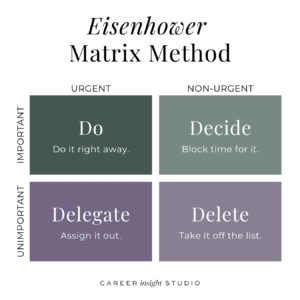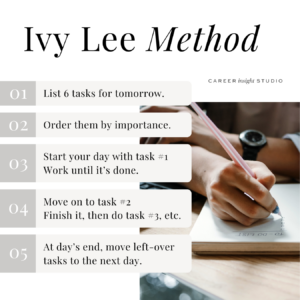If you are ready to take back your day to focus on the important vs. urgent things in your life, here are two simple but effective prioritization tools you need to use.

When you’re balancing a career, family, fur babies and everything else life throws your way, it’s easy to feel consumed with never-ending to-do lists (and lose yourself in the process). But what if you could take back control and prioritize what truly matters?
It’s not just about squeezing more into your day; it’s about making intentional choices that align with your values and things that are truly important vs urgent. There’s no shortage of information about prioritization and time management out there but I’ve found two go-to methods that have been consistently helpful for me: the Eisenhower Matrix and the Ivy Lee Method.
These tools aren’t just for managing your long to-do list—they’re for reshaping how you approach your day, helping you focus on what really matters while letting go of the rest. Let’s dive in and start building that muscle to help reclaim more of your precious time!
The Eisenhower Matrix Method
The Eisenhower Matrix, also known as the Urgent-Important Matrix, is a decision-making tool that helps you prioritize tasks based on urgency and importance. It’s basically triage for prioritization.
Fun fact: This method was popularized by Dwight D. Eisenhower, the 34th President of the United States, who was known for his exceptional time management skills!
Here’s how to use it:
Step 1. Create a Grid
Draw a simple 2×2 grid. Label the columns “Urgent” and “Not Urgent” and the rows “Important” and “Not Important.” Don’t overthink this part. A simple grid on scratch paper works great!

Step 2. Categorize Tasks
Next, list your tasks and categorize them into one of the four quadrants:
- Quadrant 1 (Urgent and Important): Tasks that require immediate attention and have significant consequences if not completed. These are your top priorities.
- Quadrant 2 (Not Urgent but Important): Tasks that are important for long-term success but don’t need immediate action. Schedule time for these activities.
- Quadrant 3 (Urgent but Not Important): Tasks that require immediate attention but are not crucial to your goals. Delegate these if possible.
- Quadrant 4 (Not Urgent and Not Important): Tasks that are neither urgent nor important. Minimize or eliminate these to free up time for more important activities.
Step 3: Take Action
Focus on completing tasks in Quadrant 1 first. Then, allocate time for Quadrant 2 activities, as they contribute to your long-term goals and personal growth. Delegate Quadrant 3 tasks and avoid Quadrant 4 tasks whenever possible.
Benefits of the Eisenhower Matrix
- Clarity and Focus: By distinguishing between urgent and important tasks, you can focus on what truly matters.
- Improved Decision-Making: Helps you make informed decisions about how to allocate your time.
- Enhanced Productivity: Encourages proactive planning and reduces the tendency to react to minor crises.
Here’s a short (~7 min) YouTube video on the Eisenhower Matrix if you want an additional walk through of the concept.
The Ivy Lee Method
The Ivy Lee Method is a simple yet powerful technique for prioritizing tasks. Developed by productivity consultant Ivy Lee in the early 1900s, this method has truly stood the test of time due to its effectiveness.

Here’s how to use the Ivy Lee Method:
Step 1: End-of-Day Planning
At the end of each workday, write down the six most important tasks you need to accomplish the next day. Limit yourself to six tasks to avoid feeling overwhelmed.
Step 2: Prioritize
Arrange the tasks in order of their true importance, starting with the most critical one.
Step 3: Focus on One Task at a Time
Begin your day by concentrating on the first task. Work on it until it’s completed before moving on to the next one.
Step 4: Move Unfinished Tasks
Any tasks you didn’t complete should be moved to the top of the list for the following day.
Step 5: Repeat Daily
Make this a daily habit to maintain a clear focus on your priorities.
Benefits of the Ivy Lee Method
- Simplicity: Easy to implement and doesn’t require complex tools or systems.
- Focused Work: Encourages deep focus on one task at a time, enhancing productivity and reducing multitasking.
- Continuous Improvement: Provides a clear roadmap for each day, helping you make steady progress toward your goals.
Here’s a short (~5 min) YouTube video that covers the Ivy Lee method.
Integrating Both Methods
While the Eisenhower Matrix helps you categorize and understand your tasks, the Ivy Lee Method offers a straightforward approach to tackling them. Here’s how you can integrate both methods:
- Categorize Your Tasks: Use the Eisenhower Matrix to categorize all your tasks. This gives you a comprehensive view of what needs attention.
- Prioritize Daily Tasks: At the end of the day, use the Ivy Lee Method to select and prioritize the top six tasks for the next day from your Eisenhower Matrix.
- Focus and Execute: Follow the Ivy Lee Method to work through your prioritized tasks one by one.
By combining the strategic overview of the Eisenhower Matrix with the daily focus of the Ivy Lee Method, you can effectively manage your time, reduce stress, and enhance your productivity.
Here’s to reclaiming more time for what truly matters! Any other tips that work for you? Please share in the comments below. Stay tuned for more posts on this topic — I’ll be sharing insights for managers on helping their teams with prioritization too!
Thanks for reading.




So good Danielle! Both systems are excellent and (of course) work best when we put it to work. Appreciate your wisdom!!!